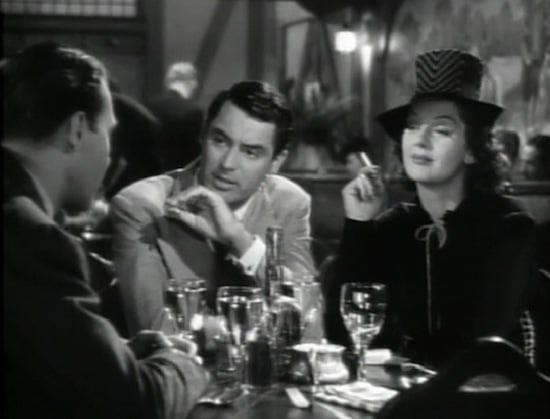Shocking Blocking (35)
By:
September 1, 2012

When analyzing the blocking of a screwball comedy, one is sorely tempted to focus on the slapstick moments. In the case of Howard Hawks’s His Girl Friday, one thinks immediately of the scene in which newsman Walter Burns (Cary Grant), in an effort to keep an escaped convict concealed inside a desk, directs his stooge Louie to drag Burns’s ex-wife Hildy’s (Rosalind Russell) mother-in-law-to-be bodily out of the room. But I’m interested in what blocking reveals about a movie’s theme — and Hawks’s theme, as Jacques Rivette was the first to point out, is “the adventure of the intellect”; specifically, the drama and comedy that result when a highly civilized society (i.e., one marked by wit, irony, and sexual sophistication) is invaded by an avatar of altogether less civilized forces. In His Girl Friday, bland insurance man Bruce Baldwin (Ralph Bellamy), Hildy’s fiancé, is the avatar of such forces. For those worried, at whatever level of consciousness, that Weimar Germany’s fate might one day be America’s, the blocking in this scene — in which Grant inserts himself bodily between Hildy and Baldwin, then comically arches his eyebrows, smirks, and waggles his cigarette until Hildy begins to fall out of love with Kultur and back in love with Zivilisation — is propaganda of the most dramatic and welcome kind.
An occasional series analyzing some of the author’s favorite moments in the positioning or movement of actors in a movie.
THIRTIES (1934–1943): It Happened One Night (1934) | The Man Who Knew Too Much (1934) | The Guv’nor (1935) | The 39 Steps (1935) | Young and Innocent (1937) | The Lady Vanishes (1938) | Mr. Smith Goes to Washington (1939) | The Big Sleep (1939) | The Little Princess (1939) | Gone With the Wind (1939) | His Girl Friday (1940)
FORTIES (1944–1953): The Diary of a Chambermaid (1946) | The Asphalt Jungle (1950) | The African Queen (1951)
FIFTIES (1954–1963): A Bucket of Blood (1959) | Beach Party (1963)
SIXTIES (1964–1973): For Those Who Think Young (1964) | Thunderball (1965) | Clambake (1967) | Bonnie and Clyde (1967) | Madigan (1968) | Wild in the Streets (1968) | Barbarella (1968) | Harold and Maude (1971) | The Mack (1973) | The Long Goodbye (1973)
SEVENTIES (1974–1983): Les Valseuses (1974) | Eraserhead (1976) | The Bad News Bears (1976) | Breaking Away (1979) | Rock’n’Roll High School (1979) | Escape from Alcatraz (1979) | Apocalypse Now (1979) | Caddyshack (1980) | Stripes (1981) | Blade Runner (1982) | Tender Mercies (1983) | Monty Python’s The Meaning of Life (1983)
EIGHTIES (1984–1993): Repo Man (1984) | Buckaroo Banzai (1984) | Raising Arizona (1987) | RoboCop (1987) | Goodfellas (1990) | Candyman (1992) | Dazed and Confused (1993) |
NINETIES (1994–2003): Pulp Fiction (1994) | The Fifth Element (1997)
OUGHTS (2004–13): Nacho Libre (2006) | District 9 (2009)
Joshua Glenn’s books include UNBORED: THE ESSENTIAL FIELD GUIDE TO SERIOUS FUN (with Elizabeth Foy Larsen); and SIGNIFICANT OBJECTS: 100 EXTRAORDINARY STORIES ABOUT ORDINARY THINGS (with Rob Walker).
